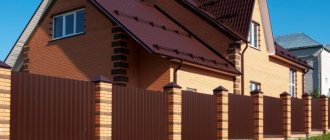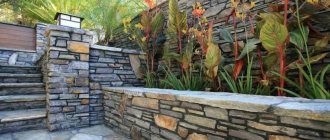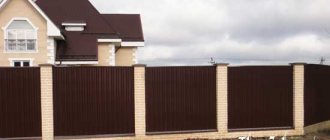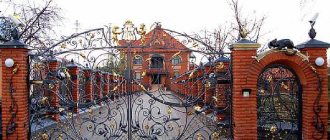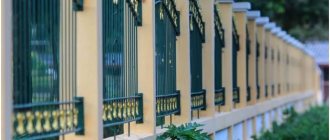According to the law, the height of the fence should not violate the interests of the owners of adjacent plots. The dimensions of the fence cannot depend only on the wishes of the owner. Violation of such norms entails the imposition of an administrative penalty, and even the demolition of the controversial fence. The parameters of the permitted height can be found in There are nuances that allow certain deviations, but for this you need to choose the right material and obtain written permission from your neighbors.
Legal fence height
The height of the fence between neighbors in a private house is a value that depends on a large number of circumstances. They should be taken into account in order to minimize conflicts with neighbors and protect yourself from penalties. We recommend reading: “Landing between neighbors: a lawyer’s answers to the most controversial issues.”
The criteria are as follows:
- the nature of the land being developed and its belonging to the community (urban area, village, ONT, SNT, dacha cooperative);
- the purpose of the installation is to delimit adjacent areas; fencing on the side of the street or the back side of a building without buildings;
- requirements of the charter of a partnership or cooperative, regulations at the local level;
- the material from which it will be made (compliance with SNIP, SP and sanitary standards);
- safety (strength corresponding to the climate of the region is taken into account; the absence of protruding structures that can cause harm).
We recommend reading: “Do you always need the neighbor’s consent, or how to install a fence without problems.”
In addition to the fencing function, the fence also has a decorative function. When erecting a fence that is too high, the damage will primarily be caused to the owner of the site. The sun's rays will not be able to penetrate the site, and the area will not receive proper lighting. In a continuous fence, you must make holes yourself at a height of 15 cm from the soil. This will allow ventilation of the area. Otherwise, the soil will systematically remain undried, and mold will form.
If the property is more than 10 acres, then they can be fenced with a two-meter fence on the side of the street along which the road runs. Some cunning owners take advantage of the beekeeping law. If there are bees on the site, it is allowed to erect a fence with a maximum height of 2 meters, separating it from the neighboring site. Residents in the village often take advantage of this opportunity.
Materials for metal fences
Metal fences can be through or continuous. They withstand wind, hail and vandals well. The downside is that some materials need to be painted regularly, otherwise corrosion will occur.
Forged rods
Rating: 5.0
The basis of the fence is a steel square 10x10, 8x8 mm or round timber with a diameter of 8-12 mm. Using a lathe, individual pins are twisted along the axis, resulting in an interesting weave of metal. Roundings and bends are made on the rollers. By forging, various petals, cones, peaks and other elements are obtained (up to the family coat of arms), which is why the fence is called forged. The parts are connected by welding in sections. The top edge of the fence can be smooth, arched, wavy or jagged. The last one is the most difficult for attackers to climb over. The fence is installed on metal or brick posts, but in any case welding will be required. The metal is most often painted black or brown, and individual forged elements are coated with gold or silver paint, which looks rich.
This material allows you to create the most exclusive fences that will not be repeated. Due to the weaving and ornateness, an elegant look is obtained that looks decent not only around the cottage, but is suitable for office buildings, hotels, and restaurants.
Advantages
- long service life;
- exclusive look;
- high mechanical strength;
- It is difficult for an intruder to climb over the fence.
Flaws
- if nothing is installed behind the bars, then the fence does little to cover what is happening in the yard;
- high price;
- A welding machine is required for installation.
Siding
Rating: 4.9
To close the area from prying eyes, another metal material is used - siding. These are steel strips 0.4-0.5 mm thick, coated with polyester. Unlike paint, such a surface better withstands exposure to ultraviolet radiation and precipitation—there is no need to paint the fence once every two years. The strips have a size of 260x226 mm or 356x330 mm and are attached to each other using a locking system with grooves. After assembly, the siding looks like a single piece. Wooden, metal or brick posts are used to secure the edges of the fence. The height of the fence can be made at any level. The material is resistant to mold and mildew and is easy to clean with a hose or rag.
The main advantage of narrow panels is the imitation of other building materials. Using siding, you can create a fence that will look like wood, stone or brick. The material can also be painted in any color according to the RAL catalog, which expands the possibilities for decorating the fence.
Advantages
- quick installation of siding together;
- variety of colors;
- imitation of the texture of stone, wood or brickwork;
- completely covers the area from prying eyes.
Flaws
- the surface is difficult to level after mechanical damage;
- not a very attractive view of the fence from the yard.
Rabitz
Rating: 4.8
The material is sold in rolls and stretched onto racks. The latter usually use concrete pillars buried in the ground or metal pipes. Fixation is carried out using hooks or bolts with nuts. The mesh is sold with different cell sections, allowing you to choose the throughput (for example, small cells of 20x20 mm are useful to prevent chickens from passing to neighbors). It is best to buy galvanized chain-link, then it will last longer in rain and snow. Although the mechanical strength of the mesh is not the highest, due to its thinness and flexibility, it is quite inconvenient for attackers to climb over it. But the material does not cover what is happening in the yard, so the area will be in full view.
Chain-link mesh is superior to other materials in its ease of installation and speed of installation. You can stretch and fix an unwound roll with a length of 10 m in just 30-40 minutes. This allows you to fence off a spacious area in literally half a day. But due to its unattractive appearance, we recommend using the material for a fence between friendly neighbors or as a fence that prevents domestic animals and birds (goats, sheep, chickens, geese, ducks, etc.) from escaping without permission.
Advantages
- quick installation;
- affordable price;
- light weight;
- galvanized mesh will last up to 25 years.
Flaws
- the yard is clearly visible through the mesh;
- weak mechanical strength.
Corrugated sheet
Rating: 4.7
This is another fence construction material that contains steel or aluminum sheet inside as a base. The outside surface is treated with pural, polyester, zinc or polyester with Teflon, which depends on the manufacturer and cost of the product. The price is also affected by the cross-section of the metal, which can range from 0.3 to 0.8 mm. For a fence, it is better to choose a thickness of 0.4 mm and above. The average service life of corrugated sheets reaches 30 years. Unlike siding, the width of the sheets is 90-130 cm, so installation is even faster. To give the panels increased rigidity, stamping is used to form a wavy or trapezoidal profile. Fastening to the racks is carried out using bolted connections or welding. Profiled sheets can be installed either with a vertical wave arrangement or with a horizontal one, which expands the variety of appearance.
The material is cheaper than siding, but is not inferior in strength. With its help, you can create a fence with any height and it will completely close the territory from the views of strangers. A large selection of colors is convenient for modeling a fence design.
Advantages
- light weight;
- complete fire safety;
- long service life;
- tolerates precipitation well;
- large selection of colors.
Flaws
- not many waveform options;
- Difficult to straighten out dents.
What to do if you want to install a high fence
There are such difficult relationships with neighbors that the best way out is not to see them at all. Then the desire arises to put up a solid fence. Such complete isolation will allow you to fully enjoy the peace and quiet in your area.
To install a high-height fence you will have to perform the following manipulations:
- erect a fence according to the norm and in compliance with SNIP along the perimeter of your site;
- step back from it by 1 meter or more, if free space allows;
- build a fence of the required height.
This option will be more expensive, but in this case there can be no claims from neighbors or individual housing construction regarding the height of the fence between neighbors.
Tips on how to reduce the cost of a fence
- Combine materials. For example, install a beautiful metal fence on the side adjacent to the street, and a cheap mesh between neighbors.
- Do some of the work yourself. To avoid paying for dismantling, remove the old fence yourself. If you feel that you can install the supports and tension the mesh yourself, do so.
- Think about where and how many wickets you will make. This part of the work costs more.
- Calculate what will be more profitable for you: order a turnkey fence or bring the materials yourself and pay only for the work. To do this, you will have to call fencing and metal supply installation companies.
- Install temporary fencing using leftover building materials. Boards, pipes, pallets, slate, even tires and glass bottles - the handy owners use everything. True, it is difficult to predict how long such a structure will last.
- Invite your neighbors to chip in for the fence. In this case, you can install better fencing while spending less money.
Step-by-step algorithm for installing a high solid fence
The permitted height of the fence between neighbors in a private house can be adjusted by erecting a decorative fence.
To do this, the following formalities must be observed:
- carry out registration of land surveying in the BTI;
- establish the boundaries of the allotment using boundary signs and take photographs. Such actions will help to fix the real boundaries of the site;
- erect a fence in accordance with all SNIP parameters. In this case, all boundary markings must be observed. It will also have to be photographed. The most optimal solution would be to insure the constructed object. This will allow you to make claims if the neighbors do not take it seriously and want to increase the area of their plot;
- make a deviation from the constructed fence by more than 1 meter; build a permanent fence of any required height. Take a photo again, which will confirm the presence of a gap between the fences.
- keep all cash and sales receipts that can confirm the costs of fence construction and insurance.
Having a fence in accordance with SNIP is a necessity. If it doesn’t exist, the neighbors will simply shift their boundaries and increase their area at the expense of another owner. After such actions, complaints about the height of the main fence will immediately arise.
What other fence parameters should be taken into account...
If you have purchased a plot of land and are planning to build houses and other structures, as well as planting trees and shrubs, then you should take into account not only the height of the fence but also the distance from the neighbor’s fence to your house, various buildings in the form of outbuildings, gazebos, garages, etc. About this We described in detail in the article: “Minimum setbacks from the boundaries of a land plot.” Since these parameters are of great importance when registering a house with Rosreestr. And by the way, if you haven’t built a fence, but are just planning, then you can use an accurate calculator to calculate the materials for the fence - huge functionality, a large selection of parameters.
What to do if a neighbor installed a high fence
It is quite difficult to protect yourself from illegal actions on the part of neighbors when they erect a fence above the established norm. The main thing to pay attention to in this case is the lack of sunlight and ventilation.
Such inconveniences will lead to excessive shading of the crop, as well as the appearance of mold. The regulatory framework for indicators such as insolation and ventilation has not yet been developed at a sufficient level. In this case, only photographs of the lost crop can help.
First you need to contact the gardening company to which the disputed area belongs. There you need to write a statement complaining about the inconvenience caused by the height of the fence. Fencing standards are always prescribed in the charters of such organizations. If it was not possible to achieve the desired result, then the next step will be to file a claim in court.
In this case, it will not be enough to simply refer to a violation of the SNT or SNIP charter. The court will only take into account violations of the Civil Code.
The application should indicate the request for the demolition of the fence in accordance with Art. 304 of the Civil Code of the Russian Federation “Protection of the rights of the owner from violations not related to deprivation of ownership.” According to it, the owner has the right to eliminate all violations of his rights, even if he is not deprived of the right of ownership. The main point is to prove that the neighbor’s installed fence actually violates the rights and interests.
Standards for lighting and ventilation of gardening and summer cottage plots have not been developed. Accordingly, proving their violation is also quite problematic. The only way out is to prove that the height of the neighbor’s fence created a shadow and significantly impaired the growth of the crop. Before referring to such a circumstance, one will have to carry out a whole scientific work:
- weigh the harvest for the previous year with photo and video recording. This action will have to be carried out in advance, but it will help in the future;
- weigh the harvest for the current year after erecting a high neighbor’s fence;
- compare them and indicate deterioration in yield.
In addition to photographic recording, witnesses will provide indispensable assistance. Enlist the help of other neighbors. The more thoroughly the evidence base is prepared, the greater the likelihood of a positive decision.
Useful tips
When building a fence it is important:
- Decide on the purpose of the fence and comply with it
- Install the structure strictly according to the technical site plan
- Choose the optimal height depending on the purpose (low, medium, high)
- Select material in accordance with budget, purpose, design and climate
- Think about the feasibility of materials maintenance costs
- Calculate the required number of support pillars
- Pour a strip foundation for a heavy wall made of stone, concrete or brick
- Find experienced builders
The tree is not suitable for humid climate zones. It is better to fence a house by the sea with plastic, metal or brick along with a hedge. And for a Siberian cottage, wood, stone or concrete are good.
Inexpensive options for painting a fence
Cheap painting means doing everything yourself, using an inexpensive version of paint, plus - doing without preliminary preparation of the surface to be painted. It will also be necessary to take into account the tool for applying paint, because the consumption of paint and varnish products depends on it:
- The paint is applied with a brush in a thick layer, hence the high consumption.
- A paint roller reduces consumption.
- Spray gun - minimal paint consumption.
Cheap options include simple painting materials:
- Lime whitewash. Brick, concrete, stone, wood - all this can be painted with lime.
- You can weld the paint yourself, fortunately there are different ways, for example, Finnish technology.
- Serebryanka is also an inexpensive option.
- Minium mixed with drying oil. Both components are sold in hardware stores.
Features of legislation
However, even according to the federal laws of the Russian Federation in 2021, there are no height restrictions for the construction of a street fence. To build a high barrier against intruders, you will not need permission to build a part overlooking a quarry or ravine. By the way, the law does not prohibit leaving hard-to-reach areas without a fence, from which access to the site is difficult due to the terrain.
Fence between neighbors in the country
The basic requirements for the construction of a barrier from the street, described in the standards, are conditional in nature - not to pose a threat to others and not to interfere with ventilation and lighting.
But since there are no standards for ventilation and illumination of public areas (at least not yet), it is very difficult to prove in a lawsuit that excessive height interferes with anything.
One way or another, in the private sector, when building a townhouse or cottage in an urban environment, restrictions adopted by city authorities or the Town Planning Code may become an obstacle.
It should be noted that the standard level of street fences is a common occurrence in an urban village or in an SNT (garden partnership). But if, after consulting with a lawyer, it turns out that the individual housing construction is located in a rural area where there are no regulations, the height requirements will be determined by other factors.
First of all, there must be a strip foundation for the fence, if a euro-picket fence or corrugated sheet is used (this also applies to heavy metal fences), the fire safety of the building, and the strength of the pillars used in the installation of the fence.
The photo below shows the fence of a private house in the village.
Fence between neighbors on a private housing plot
As a rule, experts advise limiting the height to no more than 2.2–2.5 meters. It is optimal if the owner of the land needs to limit access to any type of local area, prevent entry into it through a fence, or limit access to the garden with fruits.
In the latter case, it must be taken into account that the distance to a high tree from the fence should be at least 4 meters. And even if there are no restrictions, it is better to focus on the height of the neighbors’ fence. Otherwise, neighbors will be able to file more than one lawsuit.
Blind fencing and requirements for them
Example of a blind fence
A fence with an indicator of 5 meters or more can be erected simultaneously for several reasons, but often in order to:
- provide the required level of noise insulation (settlements are often located along highways and roads, and the first houses (townhouses with balconies) are fenced with a fence of 5 meters or less);
- ensure complete isolation between neighbors' houses.
Watch a video about the permissible height of fencing in the Moscow region according to the 2021 law.
However, it is still recommended to pay attention to the following recommendations:
- Between sections, the height of the fence should not exceed 1.5 meters. Everything above is only subject to written agreement with the neighbors.
- Blind hedges should not exceed 2.2 meters in size.
- This type of fence can be installed exclusively on the side of the roadway and the main facade of a residential building.
The following materials are often used for the construction of fences:
- slate;
- corrugated sheeting;
- brick;
- concrete;
- sheet material.
Corrugated fencing
Categories of land by purpose and type of use
The general concept of private property unites various categories of land owned by citizens. The type of use and category for the intended purpose of the site determines which specific standards, including those in the fencing segment, apply to it. Based on Federal Law No. 217-FZ of July 29, 2017, according to the type of use, land plots are divided into two categories:
- Agricultural land;
- Lands of populated areas.
With the entry into force of the new edition of Federal Law No. 217-FZ, since last year such forms of associations as DNP (dacha independent partnership) and DNT (dacha independent partnership), more simply - dacha partnerships, have ceased to exist. Therefore, today only two forms are allowed on agricultural lands.
- Gardening non-profit partnership - SNT.
- Vegetable gardening non-profit partnership - ONT.
Vegetable gardening is much less common than gardening, since the construction of even garden houses, not to mention permanent ones, is prohibited on plots for vegetable gardens. That is, if you can safely build on a gardening area, register and live all year round, which many people do, then on a plot with a vegetable garden, even overnight you can only stay in a shed with equipment or in a tent. It is logical that owners prefer to settle in comfort and in the gardens. What’s interesting is that you can be the owner of a land plot located on the territory of any SNT, but not be a member of it, since joining is voluntary.
However, the height of the fence between neighboring plots, as well as other parameters (distance to the road, location of capital and non-capital objects, etc.), even without membership, is regulated by the new SP 53.13330.2019 “Planning and development of the territory for gardening by citizens. Buildings and constructions".
But the private sector is not limited to countryside partnerships; on the lands of populated areas, and this is within the city, and in the suburbs, and in country cottage settlements, and in rural and rural settlements, two types of plots are distinguished.
- For individual residential construction - individual housing construction.
- For personal subsidiary plots - private plots (can be not only personal plots, but also field plots).
All aspects of the planning and development of plots on the lands of settlements, whether individual housing construction or private plots, are regulated by SP 55.13330.2016 “Single-apartment residential houses”. But since this code is more focused on the parameters of residential buildings, the height of the fence between neighboring sections of individual housing construction is not specified in it. In this case, the Land Use and Development Rules (LRU) of the specific municipality to which the site belongs apply. And before you start fencing the territory, you need to familiarize yourself with these rules. If the fence is built with obvious violations or in any way causes serious inconvenience to neighbors, you can end up in court proceedings, a fine, or even demolition of the structure.



